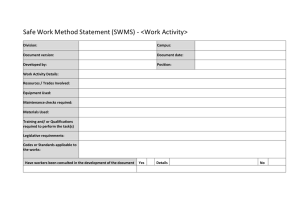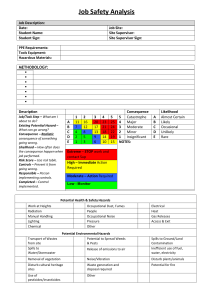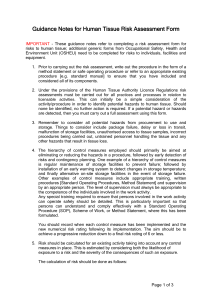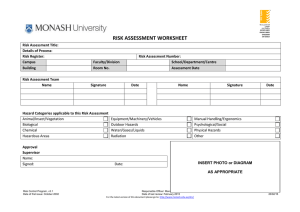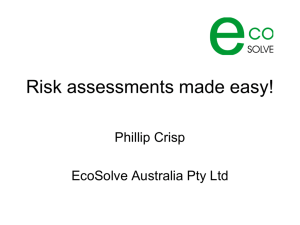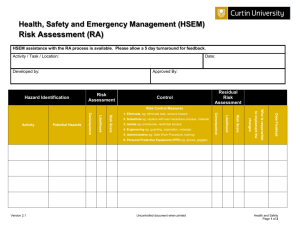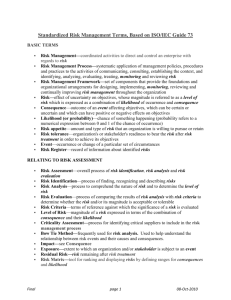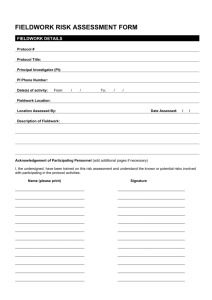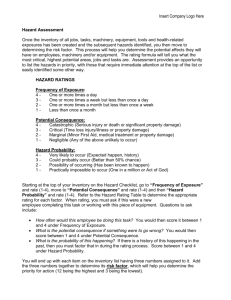Generic Risk Assessment
advertisement
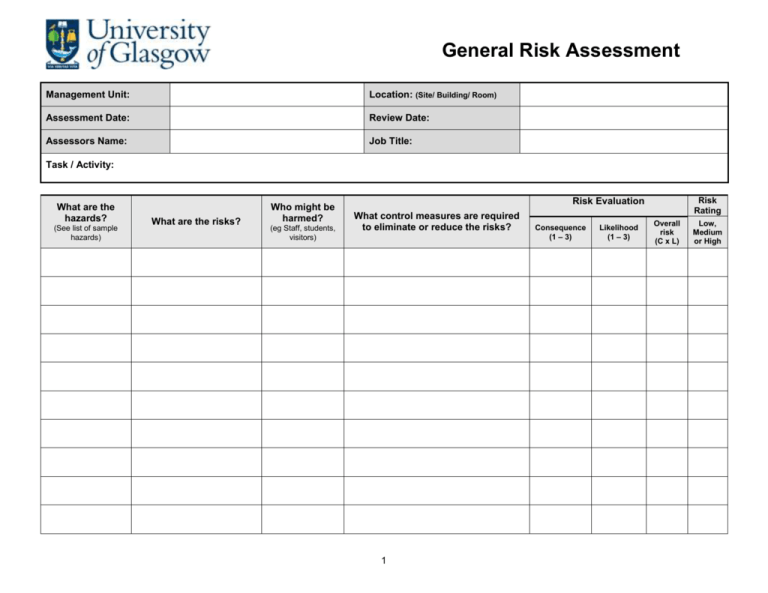
General Risk Assessment Management Unit: Location: (Site/ Building/ Room) Assessment Date: Review Date: Assessors Name: Job Title: Task / Activity: What are the hazards? (See list of sample hazards) What are the risks? Who might be harmed? (eg Staff, students, visitors) Risk Rating Risk Evaluation What control measures are required to eliminate or reduce the risks? 1 Consequence (1 – 3) Likelihood (1 – 3) Overall risk (C x L) Low, Medium or High GUIDANCE ON COMPLETION OF RISK ASSESSMENT 1. EXAMPLE HAZARDS THAT MAY BE APPLICABLE TO THE JOB or WORK ACTIVITY Working at Height Noise Hand tools Vibration Falling objects Extreme Heat / cold Confined spaces Repetitive hand/ arm movement Slippery/ uneven/ worn floors Radiation Poor housekeeping / cleaning Machine operation Obstructions/ projections Lighting Vehicle movement Electro Magnet Manual handling Compressed air Fire / explosion Pressurised systems Mechanical Lifting Substances / materials Electricity Other (specify on assessment) 2. RISK MATRIX 1 – Unlikely (injury rare, though possible) Likelihood of harm 2 – Possible (injury could occur occasionally) 3 – Probable (injury likely to occur, can be expected) Potential consequence of harm 1 – Minor Injury 2 – Significant Injury 3 – Major Injury (e.g. hazard can cause illness, injury or equipment damage but the results would not be expected to be serious) (e.g. hazard can result in serious injury and/or illness, over 3 day absence) (e.g. hazard capable of causing death or serious and life threatening injuries) 1 – Low 2 – Low 3 – Medium 2 – Low 4 – Medium 6 – High 3 – Medium 6 – High 9 – Extreme 3. RISK EVALUATION This is calculated by multiplying the likelihood against the consequence e.g. taking a likelihood of 1, which is classified as Unlikely and multiplying this against a Potential Consequence of 2, which is classified as Significant Injury, would give you and overall Risk Rating of 2, which would result in an overall evaluation as a low risk. 1 to 2 = Low risk Low risks are largely acceptable, monitor periodically to determine situation changes which may affect the risk, or after significant changes 3 to 4 = Medium risk Medium risks should only be tolerated for the short-term and then only whilst further control measures to mitigate the risk are being planned and introduced, within a defined time period. 6 = High risk High risks activities should cease immediately until further control measures to mitigate the risk are introduced. The continued effectiveness of control measures must be monitored periodically. 9 = Extreme Risk Work should not be started or continued until the risk has been mitigated. Immediate action is required to reduce exposure. A detailed mitigation plan must be developed, implemented and monitored by senior management to reduce the risk before work is allowed to commence 2
